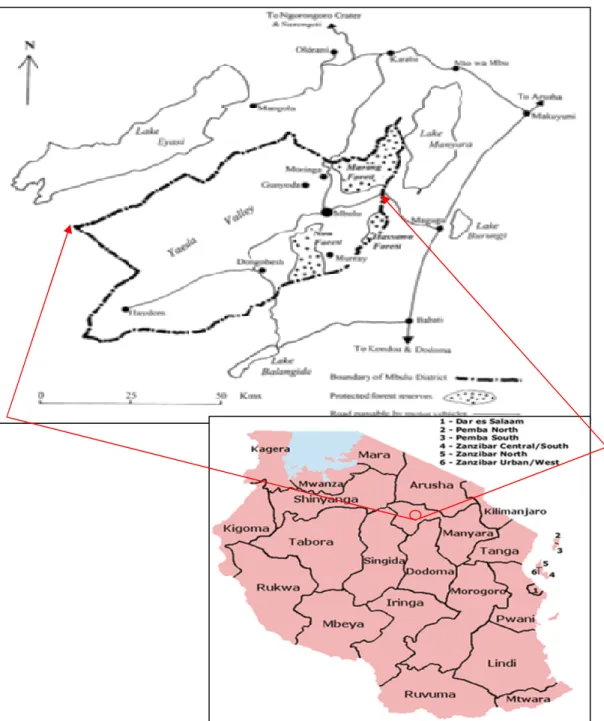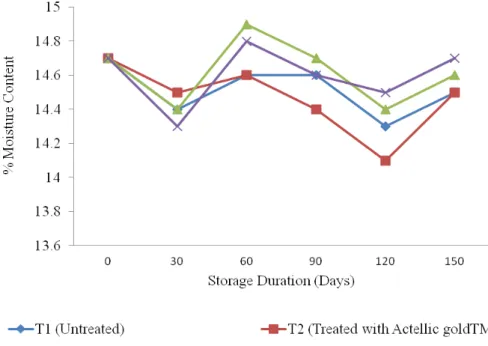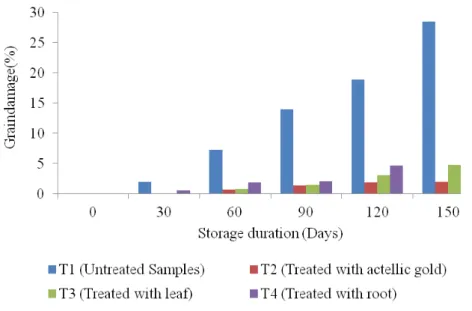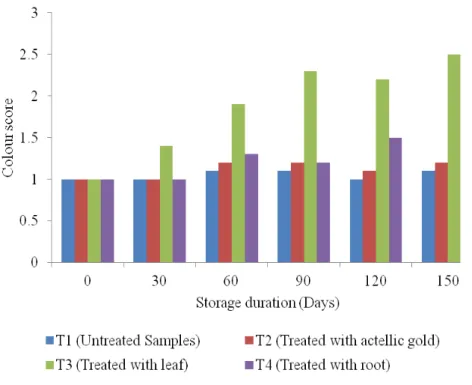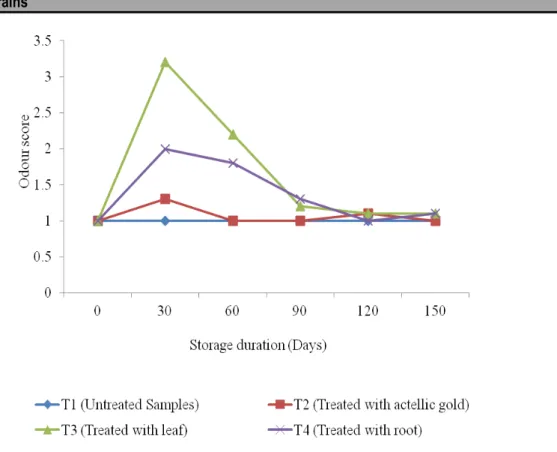Journal of Applied Biosciences 112: 11005-11015
ISSN 1997-5902
Effects of Phytolacca dodecandra Extracts on the
Quality Parameters of Stored Maize Grains
Michael Qwarse1, Matobola, J. Mihale1, Leonia Henry2, Joseph Sempombe3,Veronica Mugoyela2, and
Fortunatus Sung'hwa4.
1Department of Physical Sciences, Open University of Tanzania (OUT), P.O. Box 23409, Dar es Salaam, Tanzania. 2 Department of Science and Laboratory Technology, Dar es Salaam Institute of Technology, (DIT), P.O. Box 2958 Dar es
Salaam, Tanzania.
3 Department of Medicinal Chemistry, School of Pharmacy, Muhimbili University of Health and Allied Sciences (MUHAS),
P.O. Box 35091, Dar es Salaam, Tanzania
4 Department of Chemistry, College of Natural and Applied Sciences, University of Dar es Salaam, P.O. Box 35061, Dar
es Salaam, Tanzania.
Corresponding author email: matobola.mihale@gmail.com , Tel: +255 715 414 995
Original submitted in on 6th January 2017. Published online at www.m.elewa.org on 30th April 2017 https://dx.doi.org/10.4314/jab.v112i1.5
ABSTRACT
Objective: subsistence farmers in Mbulu district to control grain pests in stores use Phytolacca dodecandra leaves. The study evaluated the effects of leaf and root extracts of P. dodecandra on grain quality: moisture content, insect infestation, seeds germination, colour and odour over 150 days of storage.
Methodology and Results: P. dodecandra plants were collected, identified, processed and extracted using ethanol (95% v/v) and extracts stored at -4 °C for quality tests. Synthetic pesticide (Actellic goldTM dust) at 0.05
g/kg and untreated maize sample were used as positive and negative controls, respectively. No significant increase of moisture content (p <0.05) was observed in treated maize compared to controls. Leaf and root extracts minimized grain damage to <5% and <6%, respectively after 150 days post treatment. Both extracts did not affect odour, though leaf extracts affected grains colour. Both extracts insignificantly reduced seed germination index (p > 0.05) to 29%.
Conclusion and Application of findings: P. dodecandra extracts have little impact on the moisture content of the stored maize grains. Germination index of the treated maize was affected neither by the extracts nor by the storage duration up to 150 days. These marginal changes in grains moisture, odour and colour have no significant impact on the local market value of the maize grains. P. dodecandra extracts for use as biopesticide are recommended as a sustainable alternative to synthetic pesticides in maize grains storage especially for the subsistence farmers. However, further tests on biosafety and effects of the extracts on the organoleptic contents of the grains prior to consumption are recommended.
INTRODUCTION
The use of botanical pesticides is considered as a substitute to hazardous synthetic pesticides such as pyrethroid and organophosphorus pesticides due to the disturbance in the environment, increasing user cost, pest resurgence, pest resistance to pesticide
and toxic residues in food grains. Botanical pesticides are less cost effective, non-toxic to consumers and readily available for storage of large quantities of grain than the use of synthetic insecticides (Arya & Tiwari, 2013). Hence,
Subsistence farmers treat grains with plant products and oil, use cultural methods such as open sun drying and storing in barns, earthen pots, jars and airtight containers (Asawalam et al., 2006). Botanical pesticides and essential oils from various plant parts (seeds, stem roots, leaves and flower heads) have been used against field and storage pests due to their broad-spectrum pesticide activity. Some plants have been scientifically tested and found to have good pesticide properties (Kamatenesi-Mugisha, 2013). Various botanical grain protectants have been used to protect stored grains and these include Lippia javanica, Tageta minuta, Lantana camara (Muzemum et al., 2013), Eucalptus spp ( Shahzadi et al., 2010) Azadirachta indica, Nicotiana tabacum, Lonchocarpus heptaphyllus, Derris elliptica, Tephrosia vogelii, Annona squamosa, Schoenocaulon officinale, Chrysanthemum cinerariaefolium, Ryania speciosa, Rosmarinus officinale, Thymus vulgaris and Nicotiana gossei (EL-Wakeil, 2013). Plant extracts, essential oils and powder from these plants demonstrated contact toxicity (Asawalam et al. 2006; Ogendo et al., 2008), repellence (Rosman et al., 2007), fumigant toxicity (Lee et al. 2003; Rajendran & Muriladharan 2005) and anti-feedant effects (Ogemah 2003; Chebet et al., 2013) when evaluated against several storage insect pests of cereals and legumes. In many parts of the world and Tanzania in particular, the maize
weevil, Sitophilus zeamais (Motschulsky) (Coleoptera: Curculionidae) and Tribolium castaneum (Coleoptera: Tenebrionidae) are serious post-harvest pests which damage on stored grains and pulses may reach 40% particularly where modern storage technologies are not used (Pandey et al., 2011). These storage pests affect both farmers and traders. S. zeamais larvae are internal grain feeders, which affect ability of seeds to germinate lower market value of grains as well as aesthetic and grain nutritive value (Muzemum et al., 2013). Determination of plant efficacy with pesticide activity properties is a key step in the bio-prospecting of new plants based compounds in grains protection. Although the pesticides are meant for grain protection in which they have succeeded at large, some of them have shown to affect the quality of the grains adversely. P. dodecandra leaves (Figure 1) are used by subsistence farmers in Mbulu district to control grain pests in stores with minimal loss in quantity and quality. However, the use of this plant species by various societies in Mbulu district as a pesticide has not been scientifically rationalized. Therefore, this study evaluated the effect of treating stored maize grains with P. dodecandra leaf and root extracts on grain organoleptic properties (moisture content, grain damage, seed viability, colour and odour).
MATERIALS AND METHODS
Study Area : The study was carried out in Mbulu district, south west part of Tanzania (Figure 2) with
approximately 7,695 square km (including Lake Eyasi), of which 6,700 square km is a dry land.
Figure 2: Map of Tanzania showing Mbulu District (Modified from Google Earth) Mbulu district have an altitude, which ranges from 1,110
m to 2,250 m. This difference in altitude contributes to the wide range of climatic conditions with mean annual temperature ranging between 17.3 oC and 23.4 oC. In
addition, the mean annual rainfall ranges from 400 mm to
1,100 mm. The district is mainly dominated by hunters and agro-pastoral communities. There are other socio-economic activities, which are practiced including smallholder rainfed cultivation, extensive grazing, afforestation and mechanised rainfed cultivation with
medium to high inputs. The main crops grown in the study area includes maize, beans, pigeon pea, sorghum, wheat, vegetable, fruits and coffee (Brornsen et al., 2006). P. dodecandra leaves are used by small farmers to control grain pests in stores and field crops with minimal loss of quantity and quality in Mbulu district (Qwarse, 2015). Plant Material Collection and sample preparation: Phytolacca dodecandra species were collected from Mbulu district in March 2014. Botanical identification of the species was done by Haji Selemani (taxonomist) at the Herbarium in the Department of Botany, University of Dar es Salaam where voucher specimens were deposited. Plant materials were immediately separated into their component parts (leaves and roots) and placed in the open container in a dark room. The samples were allowed to air dry at room temperature in a dark room with low humidity for about two weeks. The samples were subjected to size reduction where the roots were sliced into pieces of 1 – 2 cm long, while leaves were cut into pieces of approximately 1 cm2. All samples were then
dried at room temperature for another two weeks and further oven dried at 35°C for 48 hours. Dry samples were ground into fine powders using a laboratory electric hammer mill. The powdered plant materials were then stored in an airtight glass jars in a cool place ready for extraction. Extraction of the samples was done using cold method (maceration) where plant powders were extracted using ethanol (95% v/v) for 24 hours at room temperature (Omorgbe et al., 1996). Later, the extracts were filtered, concentrated and then stored in a refrigerator at -4 °C for pesticide activity tests. Finally, the infested maize grains were collected from local maize market and screened for presence of the intended insect pests in the laboratory. Mass Rearing of Test Insects: Two hundred (200) unsexed adults S. zeamais Motschulsky insects were reared in 5 litres gas jar containing 1kg of disinfested maize grains as described by Haines (1991) and Ogendo
et al., (2004). The top of rearing jar was covered with nylon mesh fastened tightly with rubber bands. Then the S. zeamais insects were allowed to lay eggs (oviposition) for a period of 7 days. Thereafter, all adults were removed and the gas jar was monitored for 25 days where emerging adult insects were taken and kept in separate jars according to their age. The rearing test of S. zeamais insects was done in the laboratory at ambient temperature of 25 – 300C and 38- 69% relative humidity
(RH) at 12 hours of light and 12 hours of dark (L12: D12) regime (Ogendo et al., 2005).
Disinfesting of Maize grains: Maize grains used in the experiment were disinfested under a gas tight sheet for 10 days using phostoxin tablets (5g PH3 per 1000 kg of
maize) to kill any latent insect infestation according to Haines (1991) and Ogendo et al., (2004). The disinfested maize grains were kept in the laboratory under ambient conditions. Sub-samples used for grains quality evaluations were further disinfested at 40 °C in an oven for 4 hours (Ogendo et al., 2004) and allowed to cool for 2 hours before use.
Grain Quality Evaluations: The extract of P. dodecandra plant species was mixed with disinfested maize grains (1 kg). The untreated maize sample was used as negative control. Synthetic insecticide, (actellic gold™ 16 g/kg pirimiphos-methyl + 3 g/kg permethrin), 2% dust at the recommended rate of 0.05% (w/w) was used as comparative positive control (Table 1). The concentrations of P. dodecandra extracts used for grain quality evaluations were chosen based on their pesticide activities (contact toxicity, repellence, feeding deterrence) on S. zeamais and T. castaneum storage pests (Qwarse et al., 2015). A total of 20 randomly selected insects per 1kg sample were used as initial infestation.
Table 1: Treatments Used for the Grains Quality Evaluation
Treatments Description Dosage
T1 Untreated grain sample (negative control) 0 mg/mL
T2 Actellic goldTM 2% dust (positive control) 0.05 w/w
T3 P. dodecandra leaf with extract in ethanol 150 mg/mL
T4 P. dodecandra root with extract in ethanol 300 mg/mL
A total of 4 treatments in triplicate were arranged in a completely randomised design (CRD) on one-metre high wooden benches in the laboratory. All treatments were
kept at temperature of 25-30 °C, 38-69% RH and at L12: D12 regime. The baseline parameters used for quality evaluations is given in Table 2.
Table 2: Baseline Parameters for Grains Quality
Quality parameter Value (± S.E, where applicable)
Grains moisture contents (%) 14.7 ±0.14
Grain damage (%) 00 ± 00
Seed viability (%) 86 ± 0.30
Grains odour Odourless
Grains colour natural white with few yellow gains
A cylindrical grain sampler (25 mm in diameter) was used to take sub-samples (250 g) from each replicate after 0, 30, 60, 90, 120 and 150 days of grains storage according to Haines (1991) and Ogendo et al., (2004). The sub-samples were used to determine the grain quality parameters: moisture content (%), insect damage (%), seed viability index (%), grain colour and odour as described below.
Grain Moisture Content: A weighed sub-sample of about 100 grams of untreated maize grains was put in a capacitance grain moisture meter (LDS-1G, China). Direct temperature-corrected moisture content (%) readings were recorded for each grain sub-sample in triplicate. Grains Damage: The grain sub-samples were assessed for damage arising from insect infestations after 0, 30, 60, 90,120 and 150 days of storage. Each sub-sample was separated into undamaged and insect-damaged grains. The number of grains in each category was counted, weighed and the percentage weight loss (percent grains damage) of maize grains in storage was computed according to the Musundire et al., (2015). as follows:
%Weight loss = Nu)) (U(Nd DNu)x100 (UNd + −
Where: U = weight of undamaged grains, D = weight of insect damaged grain, Nu = number of undamaged grains and Nd = number of insect damaged grains.
Seed Viability Index: The effect of extract treatments, storage duration and their interactions on seeds viability were expressed as the percent germination as investigated over a 150-day grains storage period. Unbiased sub-samples of 100 undamaged grains were obtained according to the methods described in Haines (1991) and Ogendo et al., (2004). The sub-samples (100-grains) were germinated on moistened cotton wool in Petri dishes arranged in a CRD in triplicate. The experiment was maintained under laboratory conditions as described above. The number of emerged seedlings from each Petri dish were counted and recorded after 7 days. The percentage germination was computed according to Musundire et al., (2015) as follows:
Viability index (%) =
TG NGx100
Where: NG = number of seeds that germinated and TG = total number (=100) of test seeds placed in each Petri dish.
Grain Colour and Odour: The change in colour and odour of untreated and treated maize grains were assessed on a monthly basis for five months consecutively. Grain sub–samples were assessed for change in colour and odour by modification of the method described by Musundire et al., (2015). The assessment method was done by using 1-5 scoring scale which define separately each of the two parameters. However, scores at day zero (0) represent the values just before grain treatment. Scoring for change in grain colour was done according to the following scale: 1 = No detectable change i.e. natural colour (white/gray) with a few yellow grains, 2 = Slight change (≤5%) from natural colour to light brown, 3 = Moderate change (>5 to 30%) from natural colour to brown, 4 = Great change (>30 to 50%) from natural to dark brown, and 5 = Highly significant change (>50%) making grain unacceptable for human consumption. Scoring for change in odour was done as follows: 1 = Grain is odourless, 2 = Grain has little offensive odour, 3 = Grain has moderately offensive odour, 4 = Grain has offensive odour that is acceptable for human consumption and 5 = Grain has very offensive odour making grains unacceptable for human consumption. To obtain unbiased scores, each grain sample was coded and presented in a well-lit and ventilated room for assessment. A panel of six independent assessors record the change in maize grains colour and odour. The assessors were allowed into the assessment room once at a time in rotation to ensure their records were independent from each other. The procedure was repeated on a monthly basis for five month and the same six panellists were retained over the entire assessment period. Blank scoring sheets were used for the different assessment dates to ensure that the previous data do not bias subsequent scores tests (Musundire et al., 2015).
Data Analysis: Data collected were subjected to analysis of variance (ANOVA) statistical analysis. The data
presentation in form of graphs was done using Microsoft office excel 2007.
RESULTS AND DISCUSSION
Moisture Content of Treated Grains: The effects of botanical pesticides on the percent grain moisture content over a given duration of storage are presented in Figure 2. Generally, there was a slight increase in moisture content of maize treated with botanicals as compared to controls. This increase was significant (p < 0.01). This indicated that the botanical extracts have little impact on the moisture content of the stored maize grains. The results showed that the moisture content of treated and control maize grains were significantly influenced by duration of storage as indicated in Figure 3. Ogendo et
al., (2004) reported that percentage moisture content of maize grains treated with leaf and root ethanol extracts followed a more or less similar trend. Storage products are usually hygroscopic and as such, they absorb moisture from the surroundings. As there was change in temperature of the environment, the moisture holding capacity of the air increases three times (Ogendo et al., 2004). When stored products release moisture to the surroundings during low humidity, moisture content of grains is depressed.
Figure 3: Effect of the Biopesticide on Moisture Content in Stored Maize grains When the relative humidity and air temperature vary, the
maize grains moisture content is likely to vary (Ogendo, at el., 2004). This is justifiable particularly in the coastal tropics where ambient humidity and temperature tend to change throughout depending on the season in the year. Seed Viability of Treated Grains: Percent germination did not significantly (p ˃ 0.05) decrease with storage duration for the untreated maize grains, treated maize grains with actellic goldTM and with P. dodecandra, a
botanical pesticide (Figure 4). Germination decreased rapidly from 81% at day 30 to around 29% at day 90 for both botanical treatments, and later stabilised at around
viability index of 29% after 120 days. The decrease of percent germination of seeds treated with P. dodecandra leaf and root extracts dropped from 86% on day zero to 29% on day 90 as compared to 73% of the actellic goldTM
standard. However, this decrease was not significant (p ˃ 0.05). In addition, there were no significant effects of treatment and storage duration by treatment interaction on the percentage germination. Correlation analysis results show that seed viability was weakly correlated with the grain moisture content, botanical treatments and storage duration. Maize grains treated with leaf extracts had the lowest germination viability after 90 days.
Figure 4: Change in Viability of Maize Grains Treated with P. dodecandra Extracts during Storage The P. dodecandra extracts showed significant ability to
affect the germination of other plants due to chemicals that can alter the physiological and biochemical processes occurring inside the seeds (Maryam, 2010). For example, the percentage germination decreased from 90% of control to 50% when the crop seeds were treated with neem oil extract for 4 hours at 0.08 mg/mL due to botanical compounds (Rath et al., 2013). Studies indicated that decrease in percentage germination of seeds in various crops after treatment with botanical
extracts is attributed to phytotoxins, which are common in many plant species (Babu et al., 2014; Mendez & Mannuel, 2014; Mishra, 2014). However, some extracts have no effects on seed germination (Ogendo et al., 2004; Musundire et al., 2015) similar to our observations. Grains Damage during Storage: The level of grains damage was higher in untreated (negative control) maize grains than those treated with actellic goldTM and P.
dodecandra extracts (Figure 5).
The result showed that there was no significant effect (P ˂ 0.05) of storage duration and treatment duration on the level of grains damage of the stored grains. The percent of grains damage increased as duration of storage increased. This can be explained probably by the volatility or biodegradability of bioactive constituents over time. However, there was still a considerable reduction in grains damage (5%) for the 5 months of storage. Unlike the treated grains, the untreated maize grains suffered high percent grains damage compared to grains treated with actellic goldTM 2% dust and the botanical treatments
(Figure 5). As indicated in Figure 5, the present study is in agreement with a study done by Ahmed et al., (2014) who observed that Callosobruchus maculates seeds treated with extracts of neem seeds for six month reduced insect damage of the grains from about 95% to around 23%. However, a similar study by Ogendo et al., (2004) reported that maize grains treated with Lantana camara and Tephrosia vogelii for five months had insect damage percent of up to 0.7%. The relatively high insect damage
observed in this study could be due to high temperature and humidity that always prevails in coastal areas. This result are in agreement with Musundire et al., (2015) who reported that stored maize grains treated with plant powders of Tegetes minuta can reduce grains damage. Effect of Botanical Treatment on Colour and Odour Change in Maize Grains during Storage : Figure 6 shows the mean evaluation scores of colour for treated samples with P. dodecandra extracts as compared to those treated with actellic goldTM 2% dust and untreated
maize grains. The result shows that there was no significant difference (p ˃ 0.05) of the effect of storage duration, quality assessors, botanical treatments and storage interaction on the colour of the stored maize grains. The Wilcoxon scores (rank sum) increased with increased storage duration. The effect is higher in P. dodecandra leaf extract treatment compared to root extract treatment. This could be due to chlorophyll materials available in the leaves and eliminating the chlorophyll from the leaf extract might reduce this effect.
Figure 6: Effect of P. dodecandra Extracts on Colour of Stored Maize Grains The results of change in odour during storage of
untreated maize grains, those treated with actellic goldTM
2% dust and those treated with ethanol extract of P. dodecandra leaf and root are presented in Figure 7. The result shows that there was significant difference (p ˂ 0.05) of effects of storage duration, quality assessors,
botanical treatments and storage interaction on the odour of the stored maize grains. The Wilcoxon scores (rank sums) increased at 30 days of storage for botanical treatment and decreased to 120 days of storage. The effect was higher in P. dodecandra leaf extract treatment compared to root treatment.
Figure 7: Mean Evaluation Scores of Maize Grains odour after application of P. Dodecandra extracts The Wilcoxon scores for colour increased as duration of
storage increased while in odour parameter scores increased from zero days to 30 days then decreased to 90 days and became constant until 150 days of storage for the maize grains treated with P. dodecandra extracts. The untreated maize grains and actellic goldTM treated
maize grains had slight changes of score during storage period. This implies that the concentration decreased with time, possibly due to the volatility of the bioactive compounds (Ogendo et al., 2004). The evaluation results indicated that admixing maize grains with botanicals treatment started to show slightly changes in grains colour and odour over the five month of storage similar to studies done by Ogendo, (2000) and Musundire et al.,
(2015). This could indicate that the constituents from the botanical plant powders were not absorbed by the grains (Ogungbite et al., 2014). The deterioration of colour in maize grains is probably due to relatively high moisture, high relative humidity, storage period and respiration process in grains, which favour the growth of fungi such as Aspergillus favus, Penicilliun spp and Fusarium spp that produce mycotoxins (Suleiman et al., 2013). The average value for colour change was below 2.5 indicating a slight change that is tolerable in the local market. Similarly, the odour change indicated a slight offensive odour after 30 days that faded away as storage time increased.
CONCLUSION
The findings from this study have shown that P. dodecandra leaf extracts reduces grain damage and have shown promising results as a natural pesticide in storing maize grains. In addition, botanical treatment of this plant causes marginal changes in grains moisture, odour and colour with no significant impact on the local market value of treated maize grains. However, the botanical treatment reduces seeds germination of the maize grains. Further
tests are recommended to investigate the penetration of such botanical compounds into stored maize grains and their impacts on the organoleptic content of the grains. More studies on the biosafety and levels of botanical residues on the treated grains and their potential adverse effects should be done before the extracts are used to treat grains for consumption.
ACKNOWLEDGEMENTS
This work was sponsored by the Tanzania Commission for Science and Technology (COSTECH) through project No. CST/SC.327/952/3/2013 to which the authors are very indebted. The authors are grateful to the
Departments of Medicinal Chemistry and Microbiology, School of Pharmacy, Muhimbili University of Health and Allied Science (MUHAS) for providing the laboratory facilities to carry out this work.
REFERENCES
Ahmed IA, Kiyawa SA, Maryam TA, Kutama AS, Isah IB, 2014. Effects of Pre-harvest application of Lamda-cyhalothrin and Neem seed extracts in the management of Cowpea bruchid, Callosobruchus maculates Fab. (Coleoptera: Bruchidae) on stored cowpea. Global Advanced Research Journal of Agricultural Science. 3 (3): 100-105.
Arya M. and Tiwari R, 2013. Efficacy of plant and animal origin bioproducts against lesser grain borer, rhyzopertha dominica (fab.) in stored wheat, International Journal of Recent Scientific Research, 4 (5):649–653.
Asawalam EF, Emosairue SO, Hassanali A, 2006. Constituents of the Essential Oil of Vernonia amygdalina as Maize Weevil Protectants. Tropical and Subtropical Agroecosystems, 6: 95-102.
Asawalam EF, Emosairue SO, Hassanali A, 2006. Bioactivity of Xylopia aetiopica (Dunal) a rich essential oil constituents on maize weevil Sitophilus zeamais Motch. (Coleoptera: Curculionidae). J. Environ. Agric. Food Chem., 5: 1195–1204
Babu GP, Hooda V, Audiseshamma K, Paramageetham CH, 2014. Allelopathic effects of some weeds on germination and growth of Vigna mungo (L). Hepper. Int. J. Curr. Microbiol. App. Sci. 3 (4): 122-128.
Björnsen L, 2006. A History under Sierge: Intense agriculture in the Mbulu highlands, Tanzania, 19th century to the present. The Journal of the
international African institute. 76 (4).
Chebet F, Deng AL, Ogendo JO, Kamau AW, Bett PK, 2013. Bioactivity of selected plant powders against Prostephanus truncatus (Coleoptera: Bostrichidae) in stored maize grains. Plant Protect. Sci., 49: 34–43.
El Wakeil NE, 2013. Botanical pesticides and their mode of action. Springer- verleg Berlin Heidelberg. 65:125-149.
Cragg GM, Newmann DJ, Snader Kl, 1997. Natural products in drug discovery and development. J. Nat. Prod. 60, 52 – 60.
Haines CP (ed.), (1991). Insects and Arachnids of tropical stored products” their biology and Identification. A training Manual. 2nd edition.
Natural Resources Inst., Chatham United Kingdom.
Kamatenesi-Mugisha M, Buyungo, J.P., Ogwal P, Kasibante A, Deng AL, Ogendo JO, Mihale, MJ, 2013. Oral acute toxicity study of selected botanical pesticide plants used by subsistence farmers around the Lake Victoria Basin. African Journal of Environmental Science and Technology. 7(3): 93-101.
Lee S, Peterson CJ, Coats JR, 2003. Fumigation toxicity of monoterpenoids to several stored product insects. Journal of Stored Products Research, 39: 77–85.
Maryan J, 2010. Screening of selected plant species of Pakistan for their pharmacological activities. PhD Thesis, Quaid, Quaid-i-Azam University, Islamabad, Pakistan.
Mendez RM. and Manuel B, 2014. Studies on the tolerance of Vigna sinensis L and Oryza Sativa L to the application of pesticides. ISOSR Journal of Environmental Science, Toxicological and Food Technology. 8(6): 13-18.
Mishra A, 2014. Allelopathic effect of Azadirachta indica leaf extract on seed germination and seedling growth of some agricultural crops. India Journal of Applied Research. 4(5): 53-54.
Musundire R, Mazodze F, Macheka L, Ngadze RT, Mubaiwa J, Mandistera F, 2015. Eucalyptus grandisai and Tagetes minuta leaf powders effectively protect stored maize against Sitophilus zeamais without affecting grains organoleptic properties. African Journal of Agricultural research. 10(2): 49-59.
Muzemu S, Chitamba J, Mutetwa B, 2013. Evaluation of Eucalyptus tereticornis, Tageta minuta and Carica papaya as stored maize grains protectants against Sitophilus zeamais (Motch.) (Coleoptra curculionidae). Agric. Forest. Fish. 2: 196-201.
Ogemah V K, 2003. Influence of neem products on the biology and behaviour of the larger grain borer
P. truncatus and its predator Teretrius nigrescens. PhD Thesis. Humboldt University, Germany.
Ogendo JO, Deng AL, Belmain SR, Walker DJ, Musandu AAO, 2004. Effect of insecticidal plant materials, Lantana camara L. and Tephrosia vogelii Hook, on the quality parameters of stored maize grains. Journal of Food Technology in Africa. 9 (1): 29-35.
Ogendo JO, Kostyukovsky M, Ravid U, Matasyoh JC, Deng AL, Omolo EO, Kariuki ST, Shaaya E, 2008. Bioactivity of Ocimum gratissimum oil and two constituents against five insect pests attacking stored food products. Journal of Stored Products Research, 44: 328–334. Ogendo JO, 2000. Evaluation of insecticidal, and
repellence properties of Lantana camara L. and Terphosia Vegolii Hook against maize grains weevil, Sitophilus zeamais Motschulsky, in maize storage in Kenya. M. Sc. Thesis, University of Greenwich, UK.
Ogungbite OC, Ileke KD, Akinneye JO, 2014. Bio-pesticide treated jute bags: Potential alternative method of application of botanical insecticides against Rhyzopertha dominica (Fabricius) infesting stored wheat. Molecular Entomology. 5(4): 30-36.
Omoregbe RE, Ikuebe O M, Ihimire I G, 1996. Antimicrobial activity of some medicinal plants extracts on Escherichia coli, Salmonella paratyphi and Shigella dysenteriae. African Journal of Medicine and Medical Sciences, 25(4):373-375.
Pandey AK, Singh P, Palni T, Tripathi NN, 2011. Use of essential oils of aromatic plants for the management of pigeon pea infestation by pulse bruchids during storage. Journal of Agricultural Technology. 7(6): 1615-1624.
Qwarse M, 2015. Assessment of bioactivity of selected plants against pests and microbes from Agro-pastoral communities in Mbulu district, Tanzania, MSc. Thesis, Open University of Tanzania, Dar es Salaam.
Rajendran S, Muralidharan N, 2005. Effectiveness of allyl acetate as a fumigant against five stored grain beetle pests. Pest Management Science, 61: 97–101.
Rath BB, Sudhakar P, Mohantly BK, 2013. Studies on effect of Neem oil and terrosyn on the germination parameters of Vigna radiate (L.), wilczek. Int J Curr Sci. 8: 67-73.
Rosman V, Kalinovic I, Korunic Z, 2007. Toxicity of naturally occurring compounds of Lamiaceae and Lauraceae to three stored-product insects. Journal of Stored Products Research, 43: 349– 355.
Schulten GGM, 1996. From crisis control to integrated storage pest management In Farell G, Greathead AH, Hill MG, Kibata GN, (Eds.). Management of farm storage pests in East and Central Africa. Proc. Workshop of the East and central and central Africa Storage pest management Workshop, 14-19 April 1996, Naivasha, Kenya.
Shahzad I, Hassan A, Khan UW, Shah MM, 2010. Evaluating biological activities of the seeds extracts from Tagetes minuta L. found in Northern Parkistan. J.Med. Res. 4: 2108-2112. Suleiman RA, Rosenntrater KA, Bern CJ, 2013. Effects of
deterioration parameters on storage of maize. 'An ASABE meeting presentation', done in
Kansas, City, Missouri,

